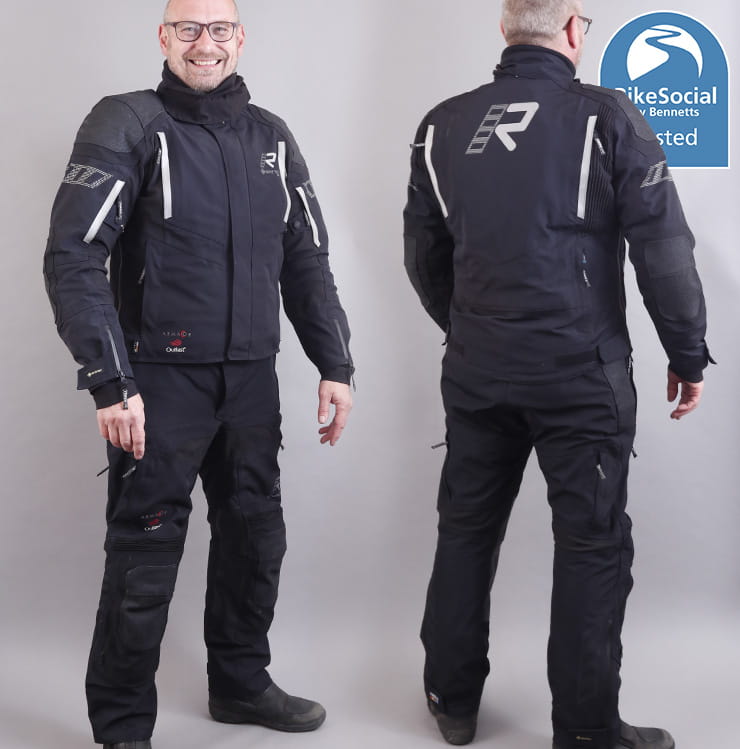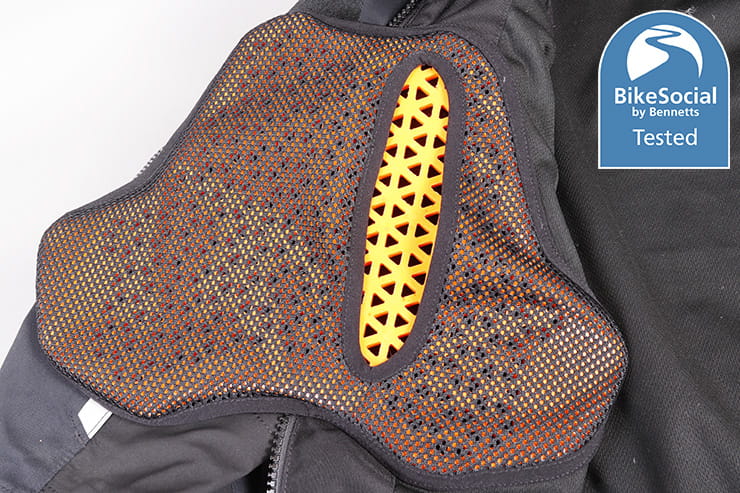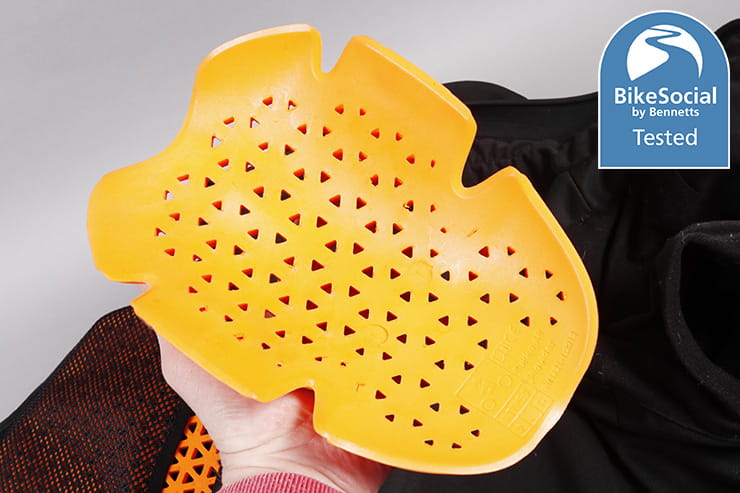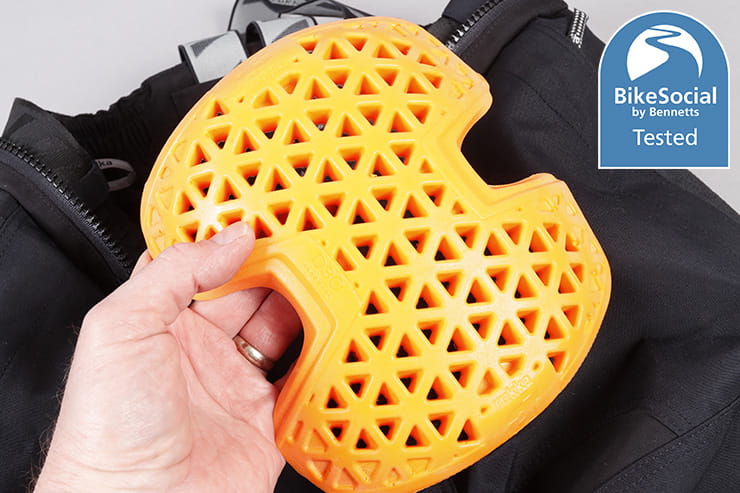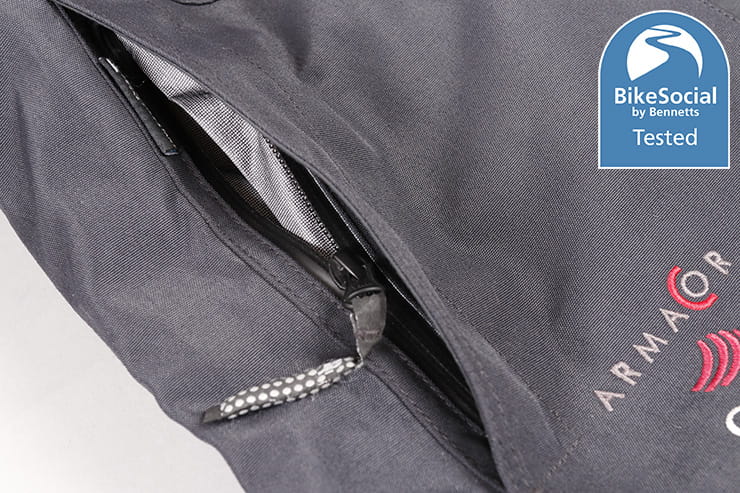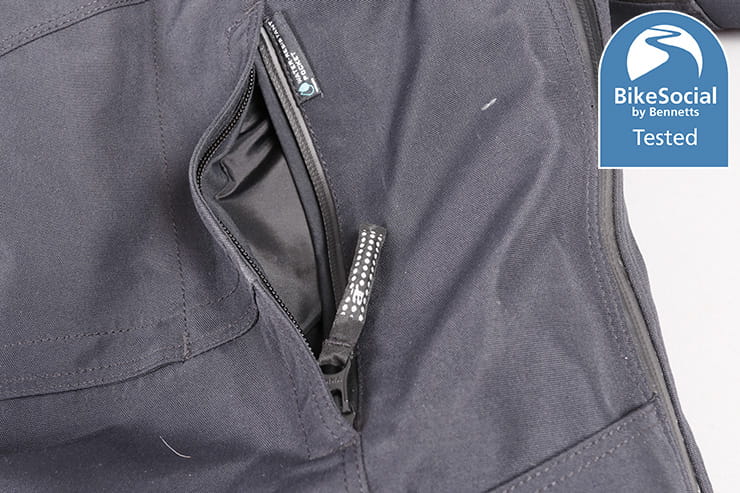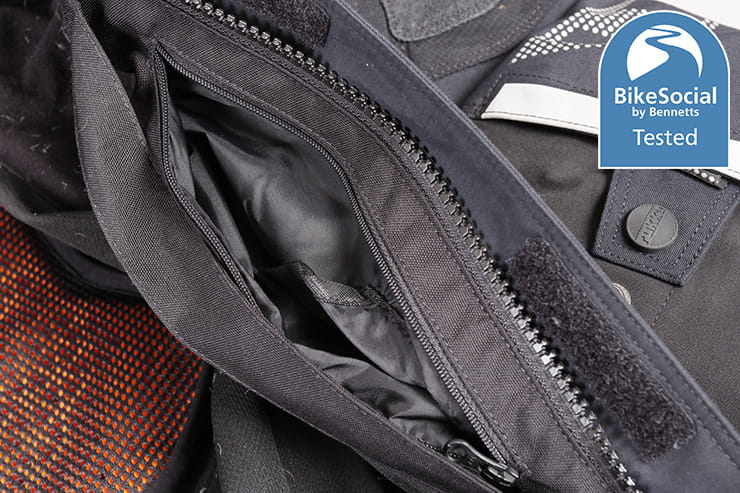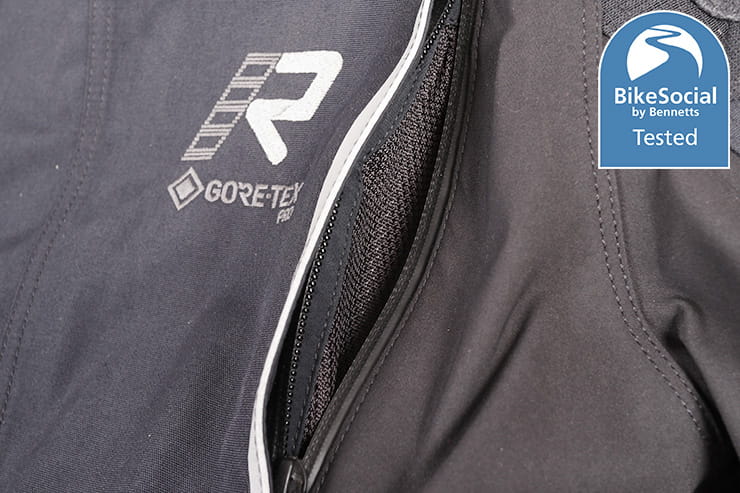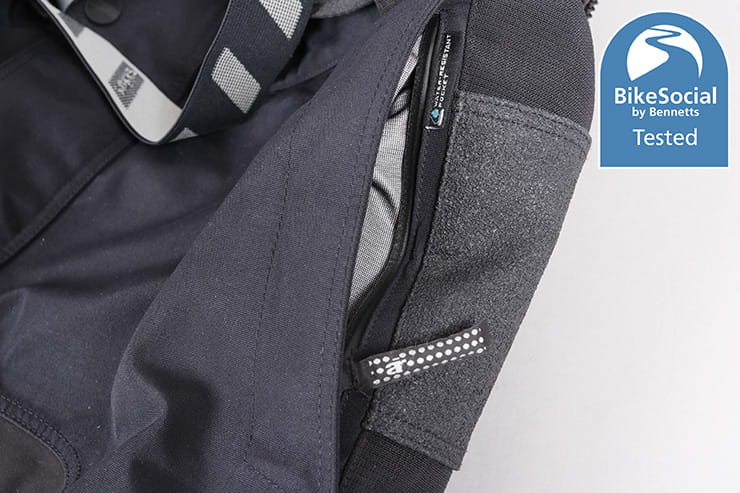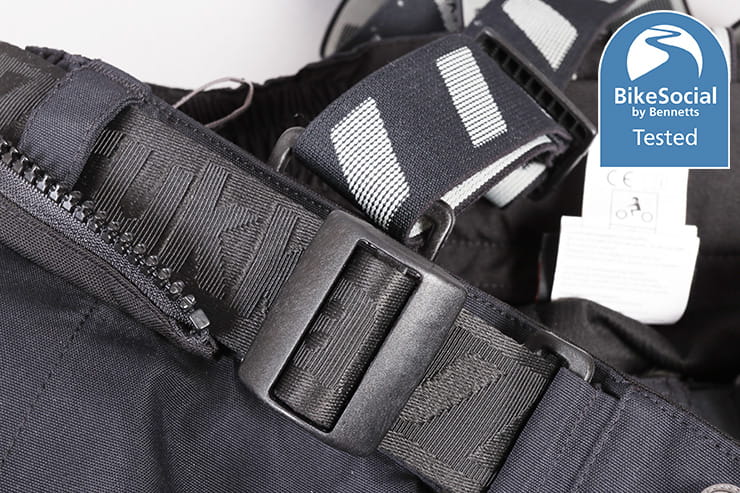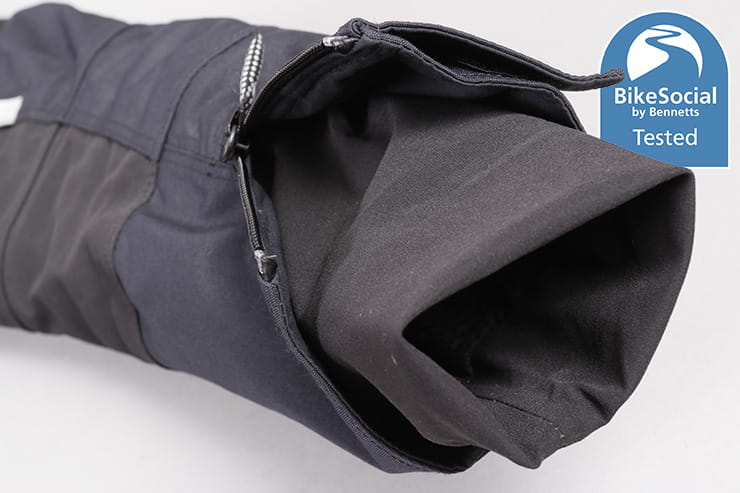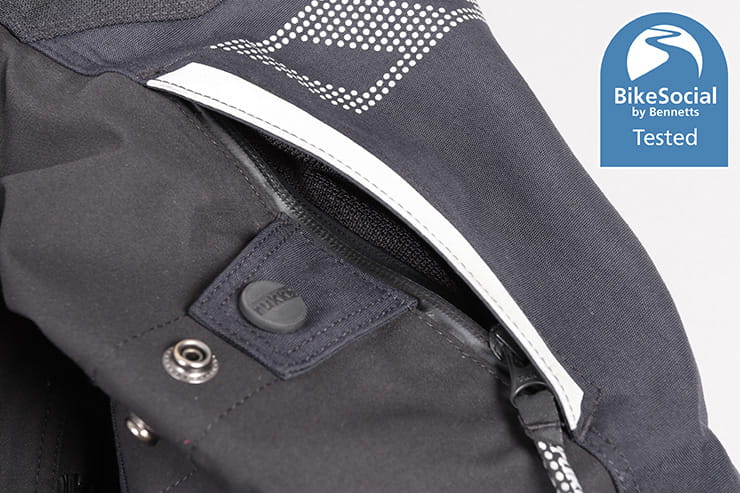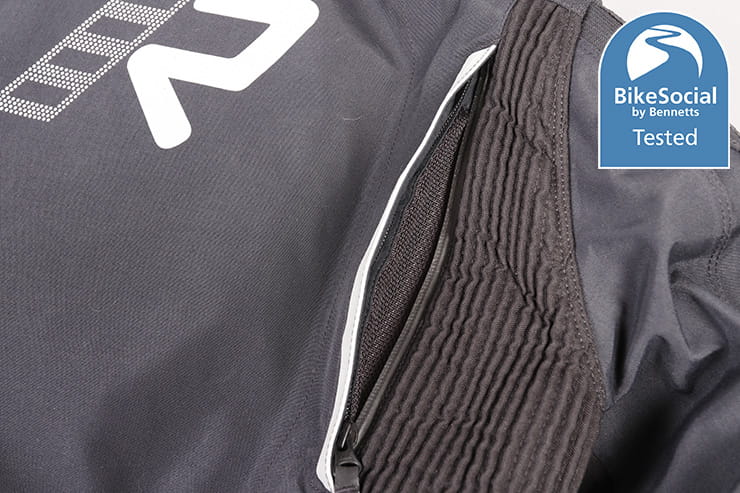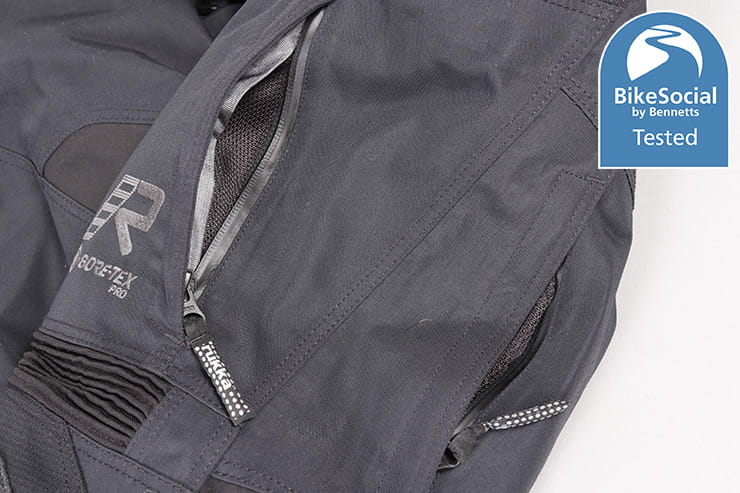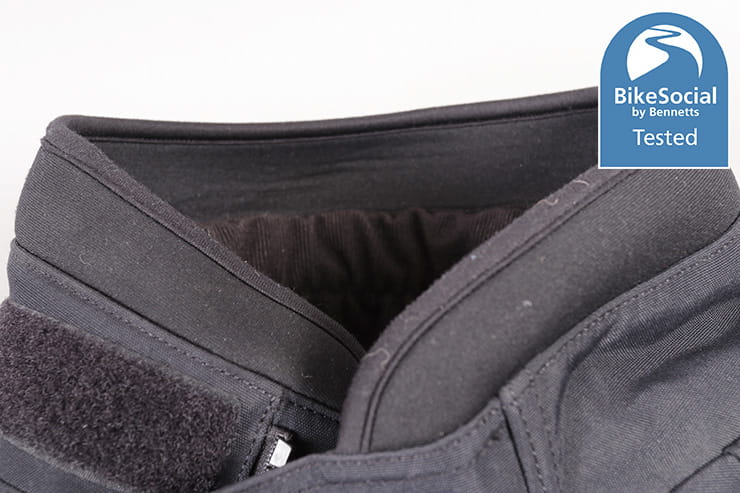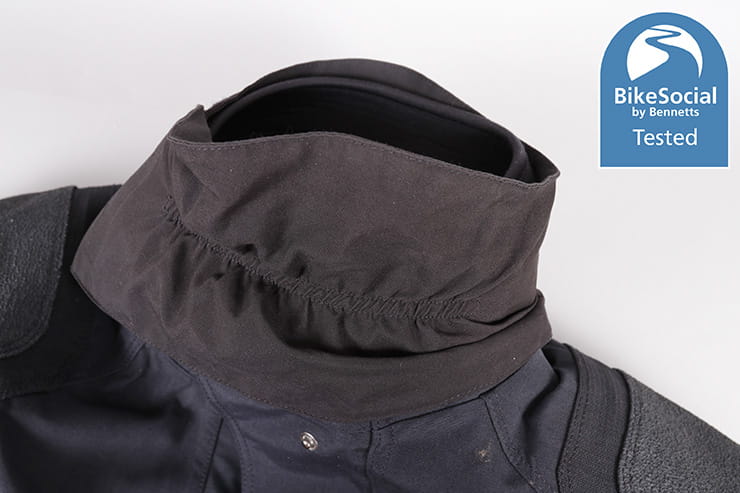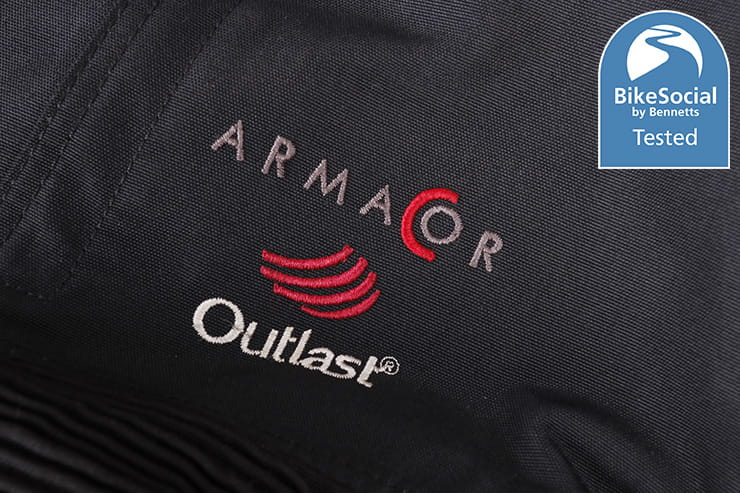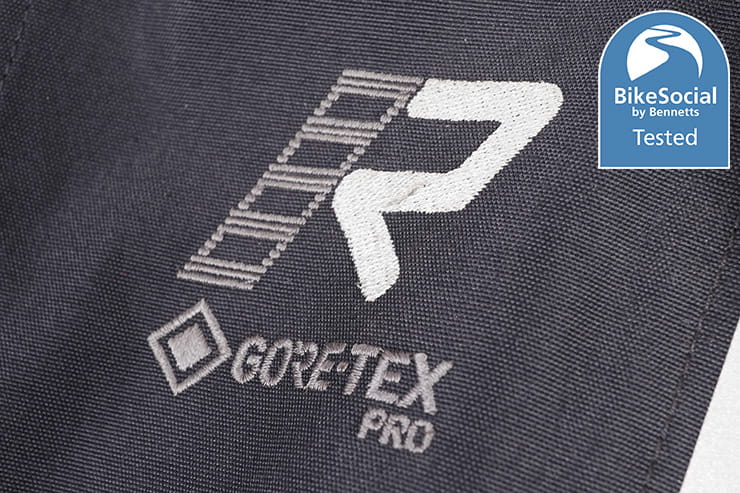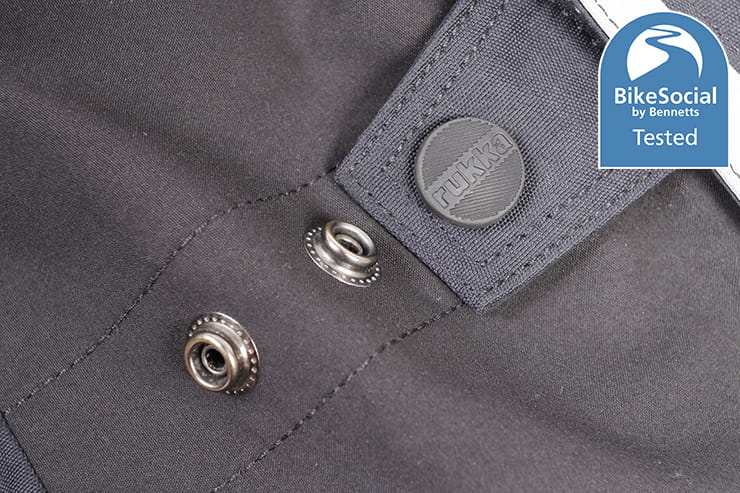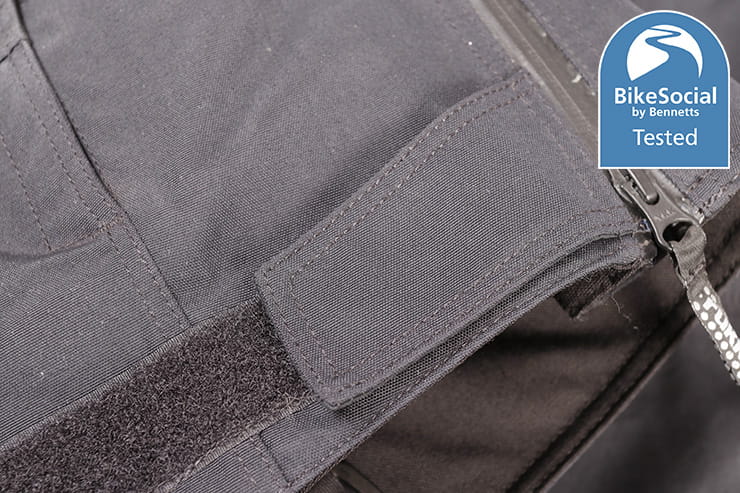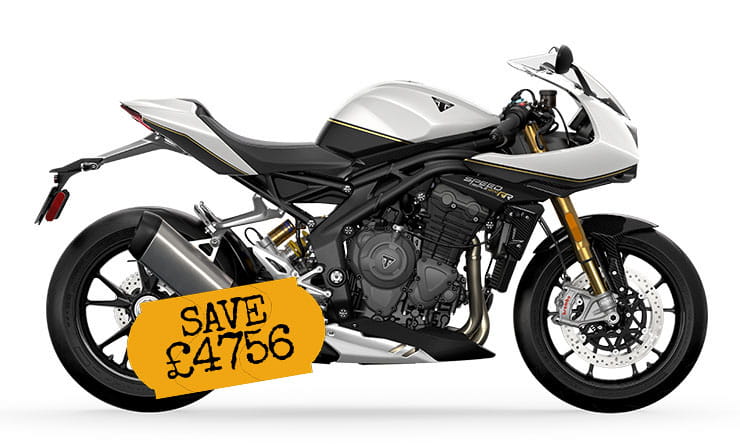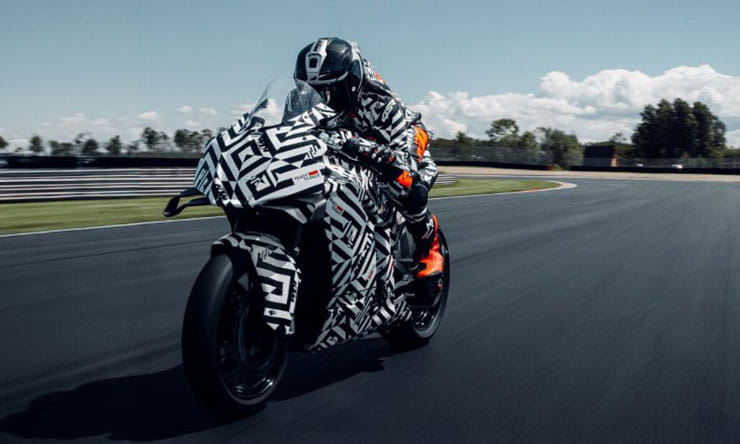Date reviewed: April 2022 | Tested by: John Milbank | RRP: £1,450.00 (jacket), £1,049.99 (trousers) | bikerheadz.co.uk
The Rukka Kingsley jacket and trousers are just about the most expensive off-the-peg textiles on the market, with only Klim appearing to make something a fraction more costly. This is the premium-end of laminated textile riding kit, so you should expect the absolute best out of it in every way.
In a world that sees the Oxford Hinterland providing complete waterproofing in a level AA suit for just £550, what does an extra two grand buy you besides my own 1999 Kawasaki ZX-6R AND the 2001 Honda VFR800 I have in the garage with enough spare for an Arai Quantic?
I’ve been wearing the Rukka Kingsley textiles for several months on the Yamaha Tracer 9 GT, BMW S1000XR and the VFR in some seriously nasty weather to find out whether it’s worth the money…
For and against
- Excellent water-proofing
- Excellent venting
- Superb armour
- Questions remain around safety performance at level AA
- Pockets are lacking a little
- Trouser hanging loops should be longer (hey, at this price you can nit-pick)
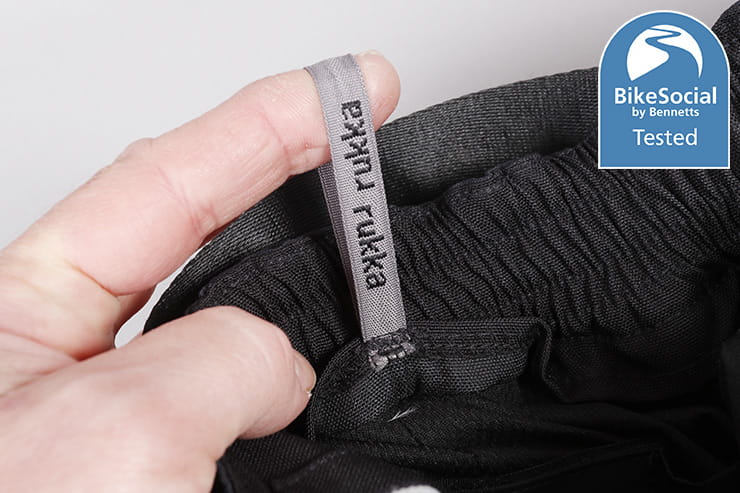
Construction and Fit
This has to be one of the most technically-constructed off-the-peg textile suits I’ve ever worn. It’s dripping in top-brand, high-spec features like Gore-Tex Pro (the top-level of laminated waterproof material), Armacor (a Kevlar/Cordura weave for abrasion resistance) and Outlast (to help regulate your body temperature).
It’s not overly heavy, the jacket weighing 3.24kg and the trousers 2.46kg (both without the extremely effective down thermal liners), but like all laminated clothing (more on that later), it is a little stiffer than some riding textiles.
However, Rukka has focused on comfort with the Kingsley, and while you know you’re wearing this kit, it’s not intrusive or uncomfortable. Of course, fit is entirely subjective, but if you’re spending this much, I’d expect you to be trying it on in store before you buy, though I’d recommend that when buying any gear you do that. Do check on your own bike if you can too – ride to the store and try it on with your machine. On an upright bike I didn’t notice, but on the VFR – where I learn forwards a little more – I did find that the top of the Kingsley’s back protector catches my lid when I tilt my head back.
The trousers feature a slim air-cushion in the rear that really does make a difference, staving off a numb-bum over longer distances, while the collar has a soft neoprene edging. Plus there’s a neck skirt permanently attached that rolls away into the collar. On the previous Navigatorr it was detachable, but irreplicable if lost. 3M Scotchlite panels are used in various spots for added visibility at night without looking over-the-top.
Another feature I’ve always been impressed with on some Rukka jackets is the double-cuff, which accommodates most of my gloves under the sleeve easily, sealing exceptionally well. Again, more on that later…
The trousers have leather on the insides of the legs that can help with abrasion protection and grip, and reduce the chance of scratching the bike. There’s also a small patch on the bottom.
Oh, and those hanging loops I mentioned in the for/against panel above? Most trousers have them, but some are longer than others. These will go over a wooden hanger, but only just, meaning they can be harder to hang up after use.
The armour in the Rukka Kingsley is huge but comfortable
Protection and certification
The armour included with the Rukka Kingsley is absolutely outstanding; D3O level 2 (the highest impact resistance) at the shoulders, elbows, back (completely full length), hips and knees, along with a level 1 protector across the chest.
But these are also unusually large protectors, covering more at the key impact areas than most other gear. Some of the top-end brands have special relationships with companies like D3O that see armour made specifically for them, rather than the generic one-size-fits-all protectors we usually get. The additional coverage is extremely valuable, and adds to protection from impacts, but also has a significant influence on the abrasion resistance of the material in that area.
My main disappointment in the Rukka range as a whole is the standard achieved under the EN17092 legislation. While some will argue that the A, AA and AAA levels are all that’s needed, these are a significant step down from the previous EN13595 tests. The most popular Nirvala suit, which costs a total of £2,149.98 only achieves level A, which is really only intended for very low speed urban riding. The level AA that the Kingsley is certified to is intended for touring use, and it’s what the vast majority of textiles now achieve.
I would say that the reinforcement in the shoulders, elbows, knees and hips of the Kingsley will be adding very welcome abrasion protection, but something about the garment means it only manages AA, be that abrasion resistance somewhere (perhaps the bottom) or something to do with the tear or seam strength tests. Only testing gives a true answer, so while Rukka stresses that it has designed its kit for the passive safety aspect of comfort – something that is very valid – I did expect top-end gear to achieve the top standard in protection under the current legislation.
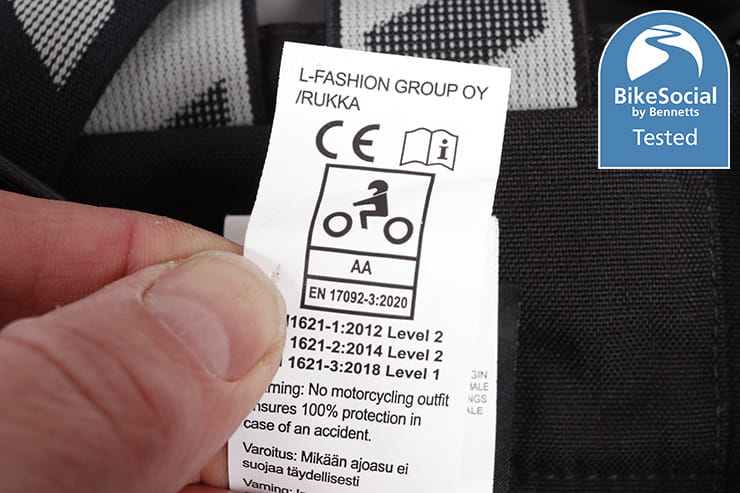
I have reviewed textile kit in the past that was almost unsafe in its lack of comfort – the Alpinestars Big Sur was an early implementation of airbag technology, but proved so bulky I took the airbag out while I tested it for water resistance in a severe storm. I ended up in an XL to try to accommodate it all, and still couldn’t get on with it (and that was when I was at least 10kg lighter than I am now).
Another argument is that on the road at least, abrasion resistance is less of an issue as you’re unlikely to slide far before you hit something. Though my first crash in 1997 was a good 65 metres before I reached a lamppost.
There’s very little off-the-peg waterproof textile kit that meets the AAA level, but some made-to-measure gear achieves the far tougher EN13595 Level 2; without having worn this myself, I can’t comment on the differences in comfort, but owners do say the tailored fit can be great all-day-long.
Ultimately, it has to be personal preference; I sincerely hope that none of us ever have to find out how protective any motorcycle kit can be. Maybe I’m expecting too much, but with very comfortable single-layer jeans managing to reach AAA, I have to admit that I’m surprised we don’t see more waterproof textile kit reaching this standard.
For everything you need to know about the safety labels in your motorcycle kit, click here.
Pockets
The jacket has two main pockets on the front, along with a map (or poacher’s) pocket on the rear, which is zipped vertically on the right.
Behind the main zip is a vertical ‘Nelson’ pocket on the left, but there are no others inside. The separate down liner does have two external and two internal pockets.
The previous Rukka Navigattor had what I consider to be better pockets, with four on the front but – more importantly for me – the two main lower front pockets were larger and had horizontal openings. I prefer these to the vertical zips on the Kingsley as you’re less likely to lose anything if you forget to close them, and also because things like my phone can float around more easily. On the VFR, with my legs drawn up more closely than on an adventure bike, my Samsung Galaxy S22 only just fits into the Kingsley’s jacket pockets, and it sits upright, pressing a little into the top of my thigh.
I could put my phone in the Nelson pocket, but then it’s a lot harder to get to when paying for fuel.
The pocket design of the Rukka Kingsley does look tidier, but for me at least, it’s a little less practical.
The trousers have a decent-sized zipped pocket on either side of the front and all of the pockets have water-resistant YKK zips. I’ve had no issues with rain getting in.
Fastening
The jacket has a smooth-running, chunky YKK zip that’s well protected by a double storm-flap, which is secured by a popper at the bottom, Velcro patches all the way up, and a Velcro patch at the collar.
A full-length zip connects the jacket and trousers, which have a zip fly and two poppers securing the waist. An integrated belt offers a good level of adjustment thanks to generous stretch sections, and a set of braces are also fitted. These are very secure, though can be easily removed if you don’t want them. As I find them extremely comfortable, I’ve kept them in place.
Rukka’s twin cuff design is superb
Adjustment
The trouser belt provides a welcome degree of adjustment, plus there are short straps on each bicep with three popper positions. There are also Velcro straps on the hem to cinch in the bottom a little.
The collar has some adjustment, as does the neck skirt, but it’s the trouser legs and jacket cuffs that stand out the most…
The legs seal very well to my boots with a long zip and plenty of Velcro adjustment – once secured, these don’t budge, and no water or drafts find their way up there.
The cuffs are one of the real stand-outs for me, with a superb two-piece design. A soft inner runs all the way up to your wrist, while the outer has enough space and adjustment to seal properly around my slim water-proof summer gloves, or my favourite Held Twin II winter gloves. If you prefer having your gloves on the outside of the cuffs (which isn’t the best way as water runs down the arm of any jacket then wicks into the glove lining), the Rukka Kingsley’s cuffs cinch down with very little bulk.
The cuffs might sound like a small thing to get so excited about, but very few manufacturers manage to get it this right. Anybody riding all year round will understand just how valuable it is to get a good seal, and to be able to get the gloves off, then resealed again quickly when stopping for fuel.
My only slight quibble would be that on the VFR, where I lean over more, I’d have liked another half inch or so of length in the arms, but this is a very personal fit thing and will depend entirely on your body shape and the bikes you ride.
Ventilation
The Rukka Kingsley’s ventilation is superb. When looking at any textiles, you need to check if the vents go ‘straight to body’. On some cheaper kit – especially that with a drop-liner – the vents can be blocked by a waterproof membrane, making them less effective. With a good design, air will still flow around the body and out of the rear exhausts, but direct-to-body venting tends to be more effective.
Starting with the trousers, there’s an intake vent on either thigh, with an exhaust behind it that helps the wind blow straight through.
On the jacket you’ll find very well positioned vents on the biceps and chest (which even manage to avoid rucksack straps), with two exhausts on the rear. The sides can also be opened from the armpits all the way down to the hem, making for an incredibly well-ventilated jacket.
If you never ride in the rain, waterproof kit is not the way to go as the membrane – be it laminated or a drop-liner – will reduce the breathability. But the venting here is absolutely excellent, making this more than wearable in almost any heat we get in the UK.
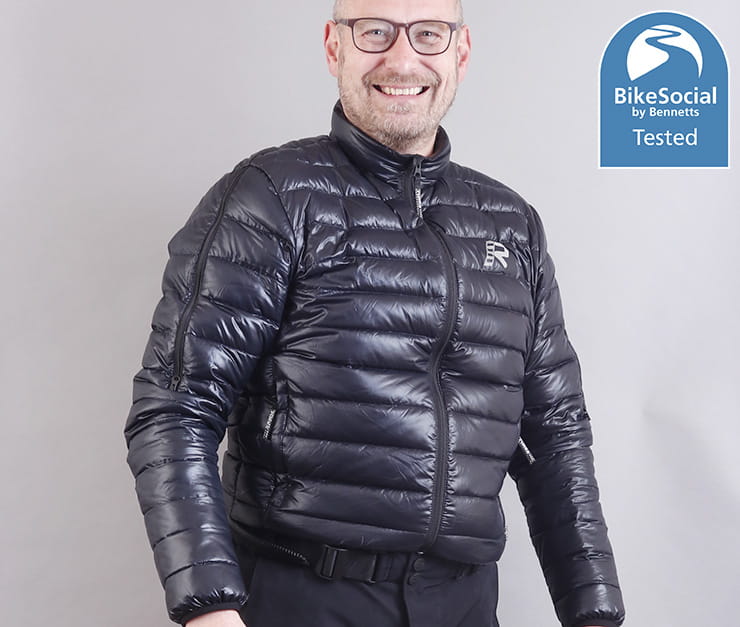
Warmth and thermal liner
When temperatures get to zero and below, a heated vest is the best bet, but the Kingsley comes with an excellent quality separate down jacket and trousers that perform incredibly well. They come with small bags that allow them to be packed away easily in luggage, though while the down jacket just about goes in the poacher’s pocket on the main shell, it’s not comfortable to wear with it in.
You can easily wear the jacket liner on its own, and there are also zips on the arms that allow you to tuck the sleeves away and turn it into a bodywarmer. It doesn’t look all that great like this though, so I’ve never bothered adapting it.
A two and a half hour ride home at 5°C in the Rukka kit with the down liner, a base layer and tee-shirt was easy. The journey there was in the morning, so ranged from 2°C to just about 5°C by the end, and there I only started to feel a very slight chill by the time I arrived. I had a heated vest in the top-box, but didn’t bother with it.
Laminated riding kit effectively loses a layer that can trap air for warmth, but the Kingsley’s package comes together well in creating something that’s very good throughout winter.
Outer shell liner
The main jacket has a mesh and soft fabric liner that’s comfortable against the skin, and that doesn’t snag or feel clammy.
Waterproofing
It’s not often that you can say motorcycle kit has kept you 100% dry, but that’s the case with the Rukka Kingsley.
First off, it’s a laminated construction, which means the waterproof membrane is bonded to the back of the outer shell, as opposed to being a floating membrane that hangs separately behind the shell. Most textiles have a DWR (Durable Water Repellent) coating that provides an initial barrier to rain before it reaches the waterproof membrane, but a heavy downpour will see this beaten and the outer material getting soaked. On a laminate construction, the outer shell will still get wet, but it dries quickly. On something with a ‘drop-liner’, the outer can soon soak right through (or wet out), which not only reduces the ability of the membrane behind to vent the warm, damp air from your body, it can also make you colder as the moisture evaporates.
No matter how bad the conditions, quality laminated textiles like the Rukka Kingsley can be shaken dry and don’t feel soggy, heavy and cold when you put them back on after stopping.
To use Gore-Tex, any brand must comply with Gore’s standards for performance and build-quality, and you’ll see two and three-layer Gore-Tex laminates used in bike kit; here it’s the three-layer Gore-Tex Pro, the third layer being a durable ‘scrim’ layer that’s bonded to the membrane to reduce wear.
Despite the vents, this truly is waterproof kit that – dare I say it – actually makes riding in the rain enjoyable. After an hour and a half in heavy rain at 4°C, I was bone dry and more than comfortable at the end of my journey.
Rukka warranty
Rukka gives a five year warranty ‘from the date of purchase against faults in material and workmanship in the motorcycle outfits. In such cases Rukka will either repair the garment or replace it.’ When bought from a legitimate UK dealer (don’t assume that a .co.uk web address means it’s really a UK store), you’ll register it on the BikerHeadz website, where’ll you’ll need to give details of where you bought it and upload a photo of the proof of purchase. You’ll then be given an extra year, taking the warranty up to six years.
You’re not covered for misuse or negligence, as well as what’s considered ‘normal wear and tear’, so while faults should be sorted (and you’ll often be able to get a loan garment while that happens), if you’re riding huge mileages and the waterproofing wears out before six years, there’s a chance this will – as with other brands – be considered ‘normal wear and tear.’
Keep your Rukka kit clean by removing all the armour then turning it inside out and washing each garment separately in the machine at 30-40°C with what the website describes as ‘a fine washing powder and no softener’. Bikerheadz (the UK importer) sells a range of cleaning products that are worth considering to keep the kit in its best condition.
Three alternatives to the Rukka Kingsley
This is the very top-end when it comes to riding kit, but there are a surprising number of options.
It’s been a long while since we tried any Klim kit, but some of that is achieving AAA, so worth a look. There’s also Stadler offering premium laminated textiles, along with Belstaff, but we don’t currently have any experience of these brands.
- The Richa Armada is a new £999.99 jacket and £699.99 trousers with a three-layer Gore-Tex Pro laminate construction. We’ve got a set booked in for review, so keep checking back at BikeSocial.co.uk for updates.
- We’ll also shortly be reviewing the Halvarssons Naren, which is a two-layer laminate that costs £479 for the jacket and £399 for the trousers; we’re expecting good things from what has tended to be a great brand.
- There is no escaping the fact that, for about the same price as this Rukka Kinglsey off-the-peg suit, you could get a made-to-measure set of textiles. Some of these are certified to the very toughest EN13595 Level 2 safety standard, and of course have the advantage of being made specifically to suit you. Only you can decide what feels best when you’re in it, but at these prices it’s worth doing your research. Always ask to see a copy of a valid certificate, and if in doubt use the Bennetts High Performance Awards, as we check the certificates for you, making it easier to find the highest-performing protective kit.
These are just three of many alternatives – you can find all the textile riding kit we’ve tested here and be sure to regularly check for the discounts available through BikeSocial membership.
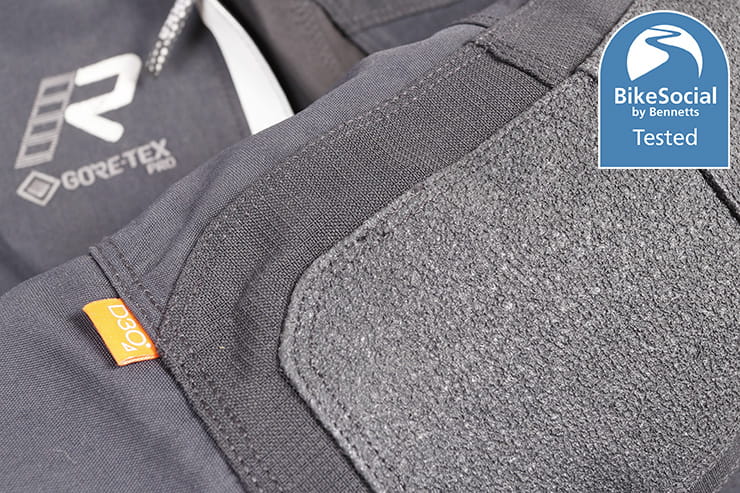
Rukka Kingsley review: Verdict
Given the extremely comfortable and versatile down liners, combined with the outstanding ventilation it’s fair to say that the Rukka Kingsley is true all-season motorcycle kit.
The D3O armour provides excellent coverage, with only the very large back-protector causing me a slight grumble when I’m riding the Honda VFR800.
So is it worth almost five times more than the Oxford Hinterland? Only you can answer that, but put all of the details of the Rukka Kingsley together – the vents, the warmth, the seal at the cuffs and legs, plus everything else, and the sum of those parts can make sense for a true all-year round rider.
I hope someone spending this kind of money will put their research in, but based on my experience of bike kit through more than 25 years as a rider and in motorcycle journalism, this is what I wear when I want to be sure I’ll stay dry and comfortable. The question in my mind would be whether to go for this or something made-to-measure, but that’s where you need to not be rushed, and to try things on for yourself.
The Rukka Kingsley might be out of the reach of many budgets, but as a top-end off-the-peg set of all-year-round bike kit, it works extraordinarily well.



